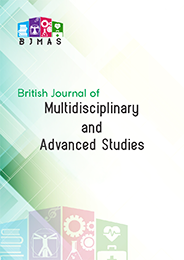Physical and Geochemical Characterisation of Pongo Pitti and Bossambo Farm Clays (Littoral Region, Cameroon) for use in Ceramics
DOI:
https://doi.org/10.37745/bjmas.2022.04167Abstract
The main objective of this work is to discern the physico-chemical and mechanical behavior of the Pongo Pitti and Bossambo Farm clay formations, located on either side of the Sanaga river in the littoral region of Cameroon. To achieve this, two field campaigns and laboratory works were carried out. Four clay materials were collected and brought back to the laboratory. The laboratory investigations involved physico-mechanical and geochemical analyses, followed by ceramic testing. The materials studied have a clayey texture, with clay percentages ranging from 26.89% to 80.3%, silt from 13.2% to 57.6% and sand from 1.58% to 47.26%. The plasticity index ranges from 11.9% to 24.2%. From a geochemical standpoint, the materials studied show a predominance of silica (49.6% to 63.5%), alumina (20.5% to 27.1%) and iron (2.39% to 8.6%), with the SiO2/Al2O3 ratio varying from 1.96 to 3.1. The Al2O3/Fe2O3 ratio is 8.4 for Pongo Pitti clays and 2.9 for Bossambo Farm clays. The geochemical weathering indices (ICV, CIA, PIA, CIW, CIW) show a high degree of weathering, with values in excess of 90%. Alkali and alkaline-earth proportions are lower, and the K2O/Na2O ratio varies between 8.45 and 14.24, showing an enrichment of potassium in relation to sodium. Lantane is the most abundant rare-earth element (323.84 ppm). The REE study shows a predominance of light REEs over heavy REEs (LREE/HREE~4.51) and a negative Europium anomaly. Infrared spectroscopy showed poor kaolinite crystallinity. Mechanically, the specimens studied, fired at temperatures ranging from 950℃ to 1050℃ showed good cohesion and metallic soundness. Linear shrinkage was 4.8%. Mass loss increases with temperature. Its value is 12.5% for Pongo Pitti materials and 8.5% for Bossambo Farm materials. Water absorption decreases with temperature and is 20.27% for Pongo Pitti samples and 15.79% for Bossambo Farm samples. Bulk density increases with temperature (2.11 at 950℃ to 2.51 at 1050℃). Flexural strength increases with temperature and is 6.66 MPa for materials from Pongo Pitti and 8.89 MPa for those from Bossambo Farm. These materials can be used to make fired bricks and roof tiles, and Pongo Pitti materials can be used to make refractory ceramics
Downloads
Downloads
Published
Versions
- 05-09-2024 (2)
- 05-09-2024 (1)












